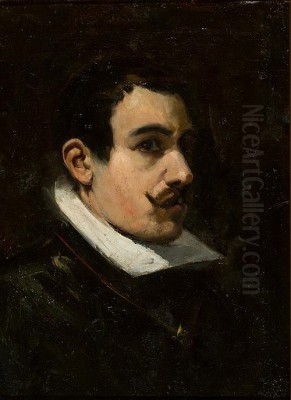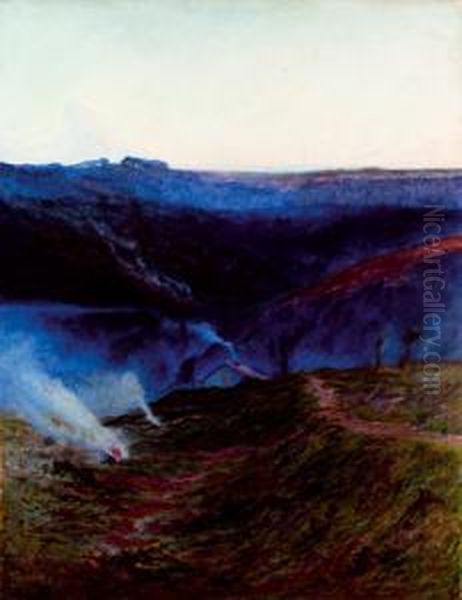
Mariano Barbasán Lagueruela stands as a significant figure in Spanish art during the transition from the 19th to the 20th century. Born in Zaragoza in 1864 and passing away in the same city in 1924, his artistic journey took him from the vibrant art scene of Valencia to the timeless landscapes of Italy, establishing him as a respected painter known particularly for his luminous landscapes and adept historical compositions. Though perhaps sometimes overshadowed by his more famous contemporaries, Barbasán carved a distinct niche for himself, blending academic precision with a keen sensitivity to light and atmosphere.
Early Life and Valencian Formation
While born in Aragon's capital, Zaragoza, Mariano Barbasán Lagueruela's formative artistic years were spent in Valencia. He enrolled at the prestigious Real Academia de Bellas Artes de San Carlos, a crucible of artistic talent in late 19th-century Spain. This institution was instrumental in shaping a generation of painters who would significantly impact Spanish art. During his studies, Barbasán demonstrated considerable promise, immersing himself in the academic disciplines of drawing, composition, and color theory.
At the Academy, Barbasán studied under influential figures such as Gonzalo Salvá and, notably, Francisco Domingo Marqués, a master known for his technical virtuosity and historical scenes. More significantly, perhaps, were his fellow students. He shared classrooms and likely artistic discussions with two individuals who would achieve immense fame: Joaquín Sorolla y Bastida, destined to become Spain's leading Impressionist or "Luminist" painter, and Salvador Abril y Blasco, another talented Valencian artist. This shared educational background in the dynamic Valencian environment provided a solid foundation for his future career.
The Call of Rome: A Defining Period

A pivotal moment in Barbasán's career arrived in 1889 when he successfully competed for and won a pension, a scholarship granted by the Provincial Council of Zaragoza, to further his studies in Rome. Italy, and Rome in particular, held an irresistible allure for artists across Europe. It was not only the repository of classical antiquity and Renaissance masterpieces but also a vibrant center for contemporary artistic exploration and a place where international reputations could be forged. The Spanish Academy in Rome served as a hub for pensioned artists, providing support and fostering a community.
Barbasán embraced the opportunity wholeheartedly, and Italy would become his home for much of his productive life. He immersed himself in the Italian environment, finding endless inspiration in its landscapes, historical sites, and the daily life of its people. Unlike some contemporaries who focused primarily on grand historical narratives inspired by Roman history, Barbasán developed a profound affinity for the Italian countryside, particularly the areas surrounding Rome.
Landscapes: Capturing the Italian Light
It was in Italy that Barbasán truly found his voice as a landscape painter. He became particularly known for his depictions of the Roman Campagna and the small towns nestled in the nearby hills, such as the renowned artists' colony of Anticoli Corrado. His landscapes are characterized by meticulous draftsmanship, a legacy of his academic training, combined with a heightened sensitivity to the effects of light and atmosphere. While not an Impressionist in the French sense, nor possessing the explosive Luminism of his former classmate Sorolla, Barbasán's work demonstrates a clear interest in capturing the specific quality of Mediterranean light.
His palette became brighter and more vibrant during his Italian years. He skillfully rendered the sun-drenched fields, ancient ruins bathed in warm light, and the picturesque villages. These works often featured genre elements – peasants working the land, shepherds with their flocks, or quiet village scenes – adding a human dimension to the landscapes. These paintings proved highly popular with the burgeoning art market, attracting European dealers and tourists who appreciated their technical skill, charming subject matter, and evocative portrayal of Italy. Artists like the earlier Spanish painter Mariano Fortuny had paved the way for detailed, brightly lit scenes of Mediterranean life, and Barbasán continued this tradition, albeit with his own distinct style.
Anticoli Corrado: An Artist's Haven

Barbasán spent considerable time in Anticoli Corrado, a small town southeast of Rome that became famous as a haven for artists from across Europe. Its rugged landscape, picturesque architecture, and the availability of local models made it an ideal location for painters seeking authentic Italian subjects. Barbasán was one of many artists drawn to its charm, and he produced numerous works depicting the town and its surroundings. His 1922 painting titled Anticoli Corrado is a testament to his connection with this place, showcasing his mature style in capturing the essence of the Italian rural scene. Other Spanish artists also frequented Anticoli, fostering a creative atmosphere.
The influence of Italian art was palpable in his work. While direct connections are sometimes hard to trace, the general atmosphere of Italian plein air painting, perhaps echoing the earlier innovations of the Macchiaioli group or the work of contemporaries like Francesco Paolo Michetti or Antonio Mancini, likely resonated with Barbasán's own inclinations towards realism and capturing light outdoors. He shared this interest in Italian subjects with other Spanish painters working in Italy, such as José Benlliure y Gil and Enrique Simonet Lombardo, though each developed their unique approach.
Historical Painting: Duty and Recognition
Despite his evident passion and success with landscape painting, Barbasán did not entirely abandon historical themes. In the academic tradition of the time, large-scale history paintings were often considered the highest form of artistic achievement and were crucial for securing official recognition, commissions, and prestigious scholarships or pensions. Barbasán engaged with this genre, often choosing subjects from Spanish history, particularly Aragonese history, reflecting his origins.
A significant example is his work Pedro III el Grande en el collado de las Panizas (Peter III the Great at the Pass of Panizas), painted around 1918. This painting, depicting a medieval Aragonese king, fulfilled the requirements of his pension and was later donated to the Spanish state. Such works required extensive research, careful composition, and a more formal, narrative approach than his landscapes. They placed him in the lineage of prominent Spanish historical painters like Eduardo Rosales and his fellow Aragonese artist Francisco Pradilla Ortiz, who had achieved great fame with monumental historical canvases. While competent and well-executed, these historical works perhaps lacked the personal connection and luminous vibrancy that characterized his Italian landscapes.
Notable Works and Artistic Signature
Mariano Barbasán Lagueruela's oeuvre includes a range of subjects, but his Italian landscapes remain his most celebrated contribution. Key works illustrating his style include:
Paisaje italiano (Italian Landscape, 1917): A representative example of his mature landscape style, likely depicting the Roman Campagna or a similar area, showcasing his skill with light and composition.
Anticoli Corrado (1922): A specific depiction of the artists' colony, highlighting his connection to the place and his ability to capture its unique atmosphere.
Pedro III el Grande en el collado de las Panizas (c. 1918): His major historical work, demonstrating his academic training and ability to handle complex narrative scenes.
Paisaje castellano (Castilian Landscape, 1913) and Coche nocturno (Night Car/Coach, 1913): Smaller studies indicating his versatility and interest in different light conditions and subjects, possibly from visits back to Spain.
His signature style involves a careful balance between detailed realism and atmospheric effect. His brushwork is generally controlled and precise, defining forms clearly, yet he masterfully conveys the warmth of sunlight, the coolness of shadows, and the texture of stone, foliage, and earth. Unlike the looser, more suggestive brushwork of Impressionism, Barbasán maintained a commitment to structure and finish, appealing to patrons who valued traditional craftsmanship alongside modern sensibilities towards light and color. His work can be seen as a bridge between 19th-century academic realism and the brighter palettes influenced by plein air painting, similar in spirit, if different in execution, to landscape specialists like Martín Rico y Ortega, known for his detailed Venetian scenes.
Contemporaries and Context
Barbasán worked during a rich period in Spanish art. His time at the Valencia Academy placed him alongside the burgeoning talent of Joaquín Sorolla. While they shared Valencian roots and an interest in light, their paths diverged. Sorolla embraced a more radical, impressionistic technique, achieving international stardom with his dynamic beach scenes and portraits. Barbasán pursued a quieter, though successful, career focused on meticulously rendered landscapes, primarily for the Italian and broader European market. His relationship with Salvador Abril y Blasco remained that of a contemporary from the same formative environment.
In Rome, he was part of a significant contingent of Spanish artists. Figures like José Benlliure y Gil, known for his genre scenes and orientalist subjects, and Enrique Simonet Lombardo, famous for his dramatic historical and social realist paintings, were also active in Italy. Barbasán's focus on landscape set him somewhat apart, though he shared their dedication to technical excellence. He navigated a world where academic traditions still held sway, particularly for official commissions, while the market increasingly favored more intimate, light-filled subjects inspired by direct observation of nature.
Later Years and Legacy
Mariano Barbasán Lagueruela spent the majority of his working life based in Italy, becoming a fixture in the expatriate artist community and successfully marketing his evocative landscapes. Information suggests he eventually returned to his native Zaragoza, where he passed away in 1924. His life appears to have been one of dedicated artistic production rather than dramatic public events.
His legacy is that of a highly skilled and sensitive painter who excelled in capturing the landscapes and light of Italy. While perhaps not as revolutionary as some of his contemporaries, he holds an important place in Spanish art history, particularly within the Aragonese and Valencian schools. He represents a successful adaptation of academic training to the late 19th and early 20th-century taste for realistic, yet atmospheric, landscape painting. His works are held in major Spanish collections, including the Museo del Prado in Madrid and the Museo de Zaragoza, as well as in numerous private collections, attesting to the enduring appeal of his art.
Mariano Barbasán Lagueruela remains a testament to the depth and diversity of Spanish art at the turn of the century. His dedication to his craft, his mastery of light and detail, and his evocative depictions of the Italian countryside secure his position as a respected master, a vital contributor to the rich tapestry of European painting during his era. His work continues to charm viewers with its tranquil beauty and technical brilliance.